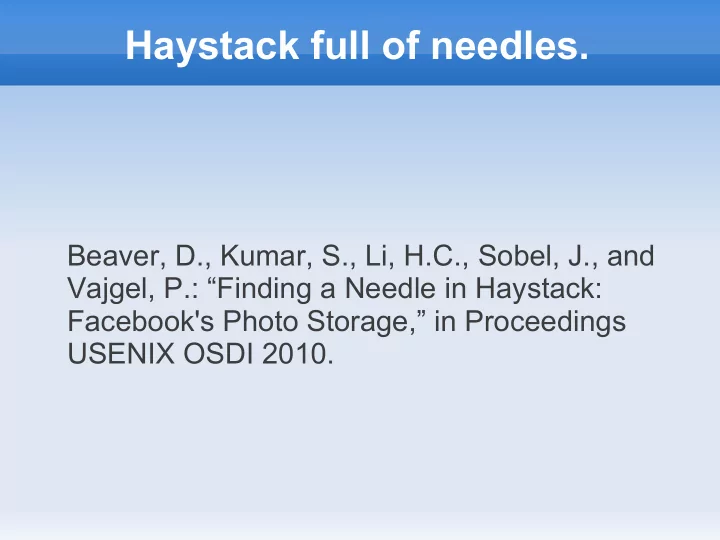

Haystack full of needles. Beaver, D., Kumar, S., Li, H.C., Sobel, J., and Vajgel, P.: “Finding a Needle in Haystack: Facebook's Photo Storage,” in Proceedings USENIX OSDI 2010.
Introduction 65 billion photos (in 4 copies) 260 billion images 20 petabytes of data 1 billion photos each week (~60 terabytes) 1 million views per second (at peak)
System specification System stores specific data which is: Written once Read often Never modified Rarely deleted
Requirements High throughput Low latency Fault-tolerant Cost-effective Simple
Problem? All exisiting storage system performed poorly on facebook workload.
Background
NFS-based Design
NFS-based Design NFS directories – large directory blockmap. 10 op. before reducing directory size. After reducing – 3 op. : Read directory metadata Load inode Read file content CDNs effectively serve cached photos (new ones) Problem? Long tail!
Solution Store files metadata in main memory Problem? Inode size... xfs_inode_t takes 536 bytes So let's make metadata smaller!
Haystack overview Haystack Store Haystack Cache Haystack Directory
Haystack overview
Haystack Store Manages filesystem metadata for photos Storing data in few copies Why is effective?
Store layout
Needle metadata
Store index
Store index Can be stored in main memory Despite asynchronous update can be updated on reboot (or on photo demand)
Store usecases Photo read Photo write Photo delete Photo change?
Store optimizations Compaction – coping (skiping deleted and altered files) Reducing metadata (now it is 40bytes per image) Batch upload. Better performance when writes/read only
Haystack Directory Mapping from logical volumes to physical (used during uploads and for URL construct) Balances writes across logical volumes and reads across physical Determines whether use CDN or not Identifies read-only volumes.
Haystack Cache Extended cache Cache only data when: Request is direct form user Photo is fetched form write enabled vloume Used to protect write-enabled volumes
Evaluation: Daily traffic
Evaluation: Directory
Evaluation: Cache
Evaluation: write-enabled machine
Evaluation: read-only machine
Concusion System handling long tail content (crucial in social network) Fault-tolerant Higher troughput Less cost Simple Scalable
Questions?
Thank you! Przemysław Spodymek
Recommend
More recommend